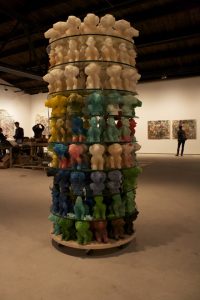Sugar Tower (SchimmelMuseum)
Hamburg . 1994 . 445 x 96 x 96 cm
Wood, glass, sugar, food and acrylic paint
I found this interesting art installation in a book by Dieter Ross called Unique pieces. I chose this because of the interesting use of materials used to create this piece; the incorporation of food items such a sugar in an art installation intrigued me. In the description, it tells you its displayed in SchimmelMusuem; Upon heading to the Museums website I find that this Museum brings two floors of Dieter Ross installations to life. I believe this gave his work more of an experience to see and a proper setting to house his installations. The building is described as ‘somewhat mouldy’, and with its slightly worn, damp walls’. The piece I am looking at was from the ‘Sugar Kitchen’ room, however annoyingly on this website there is no explanation about what the sugar kitchens purpose was and why it was created. It just had details about how the little sugar statues were created, which is not what I wanted to know. Apart from a brief description in the Foundation section of the website which stated ‘individual pieces on show to represent each of his creative phases but also their individual mode of presentation’. The mystery behind his work and the museum really intrigued me, especially since Dieter Roth’s most consistent art forms was printing and binding books, which is completely different to his textural almost completely unexpected and random art installations. Upon further looking for more information about the artist I stumbled across another Museum website which housed another of his installations called Hauser & Wirth.

Self Tower(Schimmelmuseum) Hamburg · (Idea: 1969) 1994 · 740 x 77,5 x 77,5 cm Chocolate casts of portrait heads of D. R. as an old man, between sheets of glass, held together by steel supports
‘Fueled by artistic restlessness, Roth’s wildly experimental approach to drawing, printing, and book making eventually found its way into ambitious large-scale sculptural installations’ and ‘shared by the father and son artmaking team, that includes furniture, books, and an array of personal items reflecting not just the Roths’ practice but a defining philosophy in which art and daily life are indivisible. In seeking to pulverize traditional boundaries, Dieter Roth elevated the processes by which things happen, embracing accidents, mutations, and accretions of detail over time.’ So now I start to have an understanding of what his installations in the Schimmel Museum might be about, however it is still very loose.
I decided to revisit the original book for more information about his art installations. Interestingly I found out his introduction of more complex materials such as sausa
ge, cheese and this case sugar; was to introduce a fourth dimension to his work – ‘his works were left to age and decompose, two characteristics diametrically opposed to conventional ideas surrounding works of art. In a section called The Dieter Roth Foundation’s Schimmel Museum, I find my answer. The Selbstturm (Sugar Tower), consists of self-portrait busts, recreating a sculpture from 1968, ‘at that time Roth Parodied James Joyce’s A Portrait of the Artist as a Young Man, by portraying himself, then aged 38, as an old man. The towers were described to be arranged in almost military formation, and upon first glance quite menacing.
I look on Spark note to get a brief over view of the book, to see if I can find out anything else; it was genuinely about the life story of a catholic boy and his life struggles, sins and family and about him trying to find wings to become an artist. This leads me to believe that Dieter Roth, maybe was atheist or didn’t like the ‘dreamlike’ approach James Joyce had on being able to become and artist. You could almost argue that Dieter Roth’s sugar statue and even the whole of the Schimmel Museum was an act against the genuine ‘pretty’ artist, and using time and decay was his retaliation to the boundaries of what art can be. And that being an artist wasn’t as simple as ‘finding wings’ and being a in a dreamland, it was a competitive industry and career and required thinking out of the box; which he most certainly did with his Sugar Tower and the whole of the Schimmel Museum.

